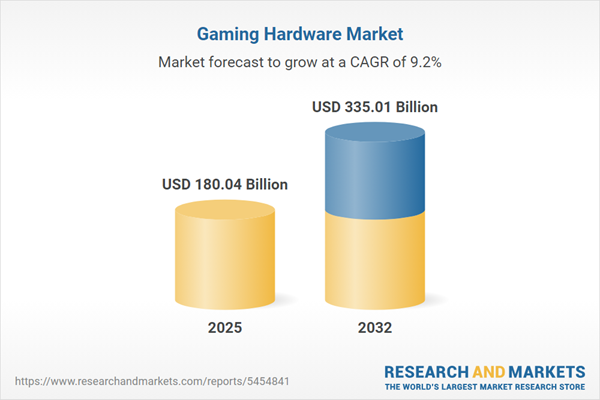Speak directly to the analyst to clarify any post sales queries you may have.
The gaming hardware market is undergoing rapid change, shaped by new technologies, evolving consumer preferences, and dynamic supply chain strategies. Senior leaders must understand the ongoing transformation to position their organizations for sustainable advancement in this evolving landscape.
Market Snapshot: Gaming Hardware Market Growth and Outlook
The gaming hardware market grew from USD 165.70 billion in 2024 to USD 180.04 billion in 2025. It is projected to maintain strong momentum with a CAGR of 9.19%, anticipating a market size of USD 335.01 billion by 2032.
Scope & Segmentation
- Product Types: Accessories (including game controllers, gaming headsets, gaming keyboards, gaming mice, racing wheels), consoles, gaming PCs, graphics processing units (covering discrete, integrated, and mobile GPUs), and virtual reality headsets (PC-tethered and standalone).
- Connectivity Types: Wired (audio jack, USB) and wireless (Bluetooth, RF) solutions, as well as hybrid configurations merging both connection modes.
- Consumer Types: Casual gamers (mobile and occasional), enthusiasts (console and PC), and professionals (content creators, esports professionals).
- Distribution Channels: Online (e-commerce, manufacturer direct) and offline (electronic superstores, specialty retailers, brick-and-mortar stores).
- Regional Coverage: Americas (United States, Canada, Mexico, Brazil, Argentina, Chile, Colombia, Peru), EMEA (United Kingdom, Germany, France, Russia, Italy, Spain, Netherlands, Sweden, Poland, Switzerland, UAE, Saudi Arabia, Qatar, Turkey, Israel, South Africa, Nigeria, Egypt, Kenya), Asia-Pacific (China, India, Japan, Australia, South Korea, Indonesia, Thailand, Malaysia, Singapore, Taiwan).
- Technology Trends: Artificial intelligence, edge computing, augmented reality, mixed reality, cloud gaming, 5G connectivity, and modular product designs.
- Leading Companies: Sony, Microsoft, Nintendo, Intel, AMD, Dell Technologies, HP, NVIDIA, Razer, Samsung, Meta Platforms, Logitech, Lenovo, and others.
Key Takeaways: Strategic Insights for Decision-Makers
- Next-generation gaming consoles and high-performance PCs increasingly integrate advanced processing, memory, and graphics capabilities, supporting highly immersive experiences.
- The adoption of cloud gaming and streaming services is shifting consumer expectations, with emphasis on cross-device compatibility and on-demand access.
- Artificial intelligence and edge computing are enhancing real-time analytics, enabling personalized and responsive user environments.
- Growth in esports and live content creation is elevating performance standards for hardware and fueling product development collaboration between manufacturers and professional users.
- Sustainability is influencing both design and procurement, with consumers and enterprises seeking eco-conscious materials and responsible end-of-life practices.
- Companies that engage in direct feedback with gamer communities and invest in modular architectures establish stronger brand loyalty and resilient product roadmaps.
Tariff Impact: Adapting to Regulatory Changes
New United States tariffs introduced in 2025 are reshaping global supply chains and pricing strategies within the gaming hardware market. Increased duties on key components are prompting firms to reevaluate manufacturing locations, explore nearshoring options, and renegotiate supplier agreements. This has accelerated efforts toward supply chain diversification, greater transparency, and collaborative joint ventures to maintain cost efficiency. Market participants with robust regional partnerships and adaptive procurement strategies are best positioned to offset regulatory risks and leverage fresh competitive opportunities.
Methodology & Data Sources
This report uses a comprehensive research methodology combining interviews with industry executives, supply chain and logistics assessments, and technology trend mapping. Primary insight is enhanced with a robust review of technical specifications, patent filings, and regulatory documentation. Multi-step validation, including peer reviews and scenario stress tests, ensures findings are accurate and actionable.
Why This Report Matters
- Enables executive teams to benchmark competitive positioning and align strategic investments with core technology trends in the gaming hardware sector.
- Highlights key consumer, product, and channel segments, supporting optimized go-to-market planning and resource allocation across global regions.
- Delivers actionable insights into regulatory and supply chain developments, helping organizations proactively manage risks and identify new market opportunities.
Conclusion
The gaming hardware market is defined by rapid technological advances, adaptive supply networks, and shifting consumer priorities. Organizations that prioritize innovation, sustainability, and real-time market intelligence will navigate ongoing change most effectively and capture new avenues for growth.
Additional Product Information:
- Purchase of this report includes 1 year online access with quarterly updates.
- This report can be updated on request. Please contact our Customer Experience team using the Ask a Question widget on our website.
Table of Contents
3. Executive Summary
4. Market Overview
7. Cumulative Impact of Artificial Intelligence 2025
Companies Mentioned
The companies profiled in this Gaming Hardware market report include:- Sony Group Corporation
- Microsoft Corporation
- A4Tech Co., Ltd.
- Advanced Micro Devices, Inc.
- Analogue
- ASUSTeK Computer Inc.
- Atari, Inc.
- BenQ Corporation
- Boat by Imagine Marketing Limited
- Dell Technologies Inc.
- DreamGEAR, LLC
- Eastern Times Technology Co., Ltd.
- HP Inc.
- Intel Corporation
- Kingston Technology Company, Inc.
- Koninklijke Philips N.V.
- Lenovo Group Limited
- LG Electronics Inc.
- Logitech International S.A.
- Mad Catz Global Limited
- Meta Platforms, Inc.
- Micro-Star INT'L Co., Ltd.
- Nintendo Co., Ltd.
- Noise by Nexxbase Marketing Pvt. Ltd.
- NVIDIA Corporation
- Razer Inc.
- Samsung Electronics Co., Ltd.
- ScufGaming by Corsair Memory, Inc.
- SEGA SAMMY Holdings Inc.
- Skullcandy, Inc.
- SteelSeries ApS by GN Store Nord A/S
- Toshiba Corporation
- V-MODA, LLC by Roland Corporation
- Valve Corporation
- Venom Limited
- Voyetra Turtle Beach, Inc.
Table Information
| Report Attribute | Details |
|---|---|
| No. of Pages | 180 |
| Published | October 2025 |
| Forecast Period | 2025 - 2032 |
| Estimated Market Value ( USD | $ 180.04 Billion |
| Forecasted Market Value ( USD | $ 335.01 Billion |
| Compound Annual Growth Rate | 9.1% |
| Regions Covered | Global |
| No. of Companies Mentioned | 37 |









